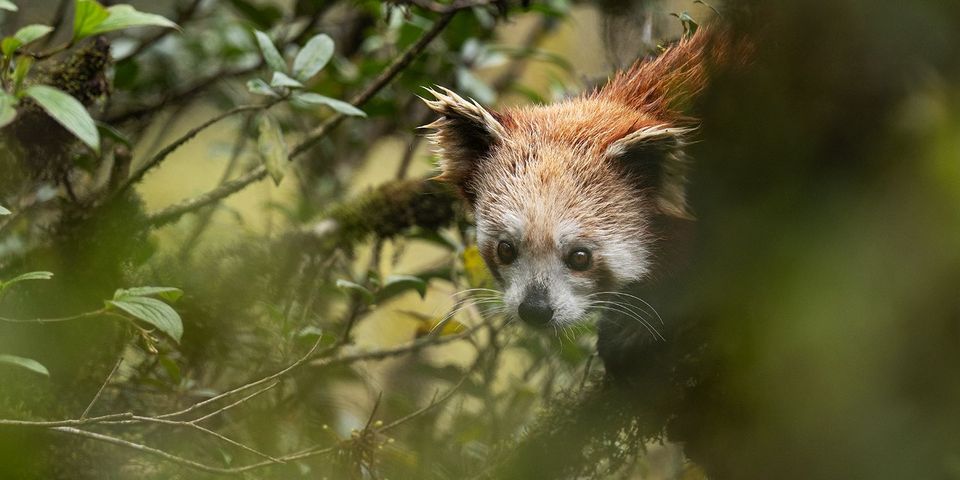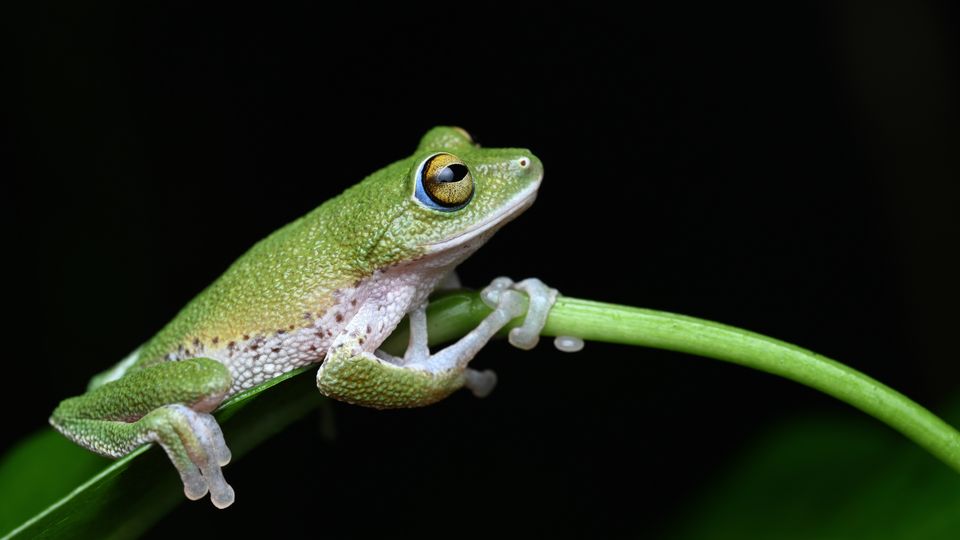In a land of ancient Land Rovers, our Mahindra Bolero Camper 4X4 made its way, slowly and a bit unsteadily. We were driving through narrow tracks that connected one village with another in the foothills of the Himalayas of Eastern Nepal. I am not sure if these tracks can be called roads, though the effort was well underway to convert them. In the process, every turn became that much more adventurous with the vehicle skidding over the wet mud and us, the plains-dwellers, awestruck (and a tad scared) at the precipitous drops that the steep hillsides showed us from time to time.
Why does one put oneself through so much discomfort? I guess, partly, it was the proverbial carrot. A quest to see and photograph an enigmatic animal - the Red Panda.
30 kilometres (and 4 hours) later, we were at our basecamp. A beautiful cottage, hosted by a wonderful family, in a tiny village settled on either side of the "road" with all of 7-8 houses. At an altitude of around 3000m, we were in the clouds. Quite literally, in fact. Just the ideal setting for the cloud forest nearby that we were going to explore over the next few days.
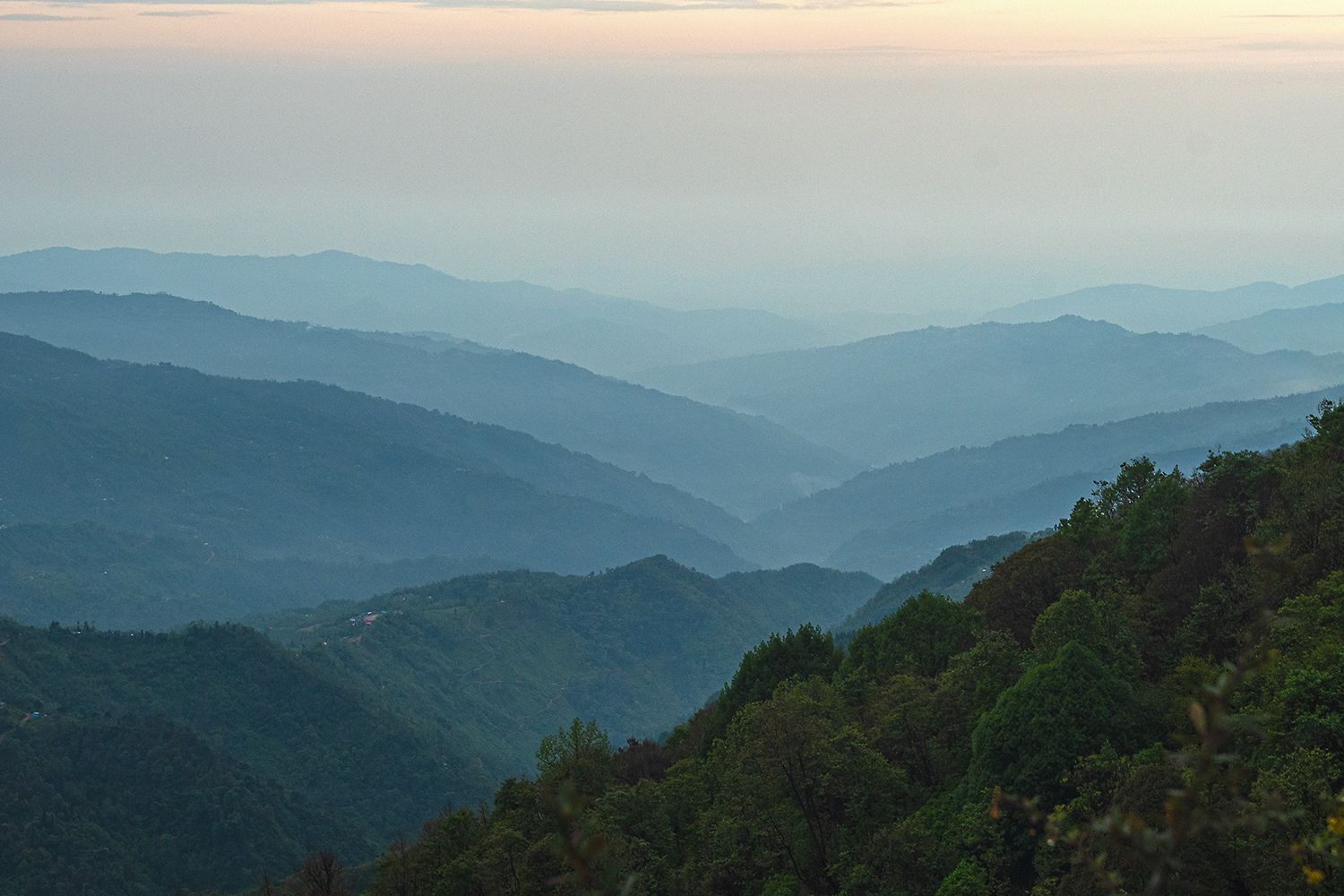
A quick lunch and "chia" (tea) and we were off on our first walk. To get used to the terrain and try our luck on that misty/cloudy afternoon. Our host SS was a dynamic 62 year young man who walked the forest like a mountain goat. Along the way, he enlightened us about the unseen around us. "Look at this hoof-mark. A Himalayan Tahr just jumped off from here, probably after hearing our footsteps." "These Rhododendrons were filled with flowers till a couple of weeks ago. It was a glorious sight." "This is good Red Panda habitat. They love this bamboo species."
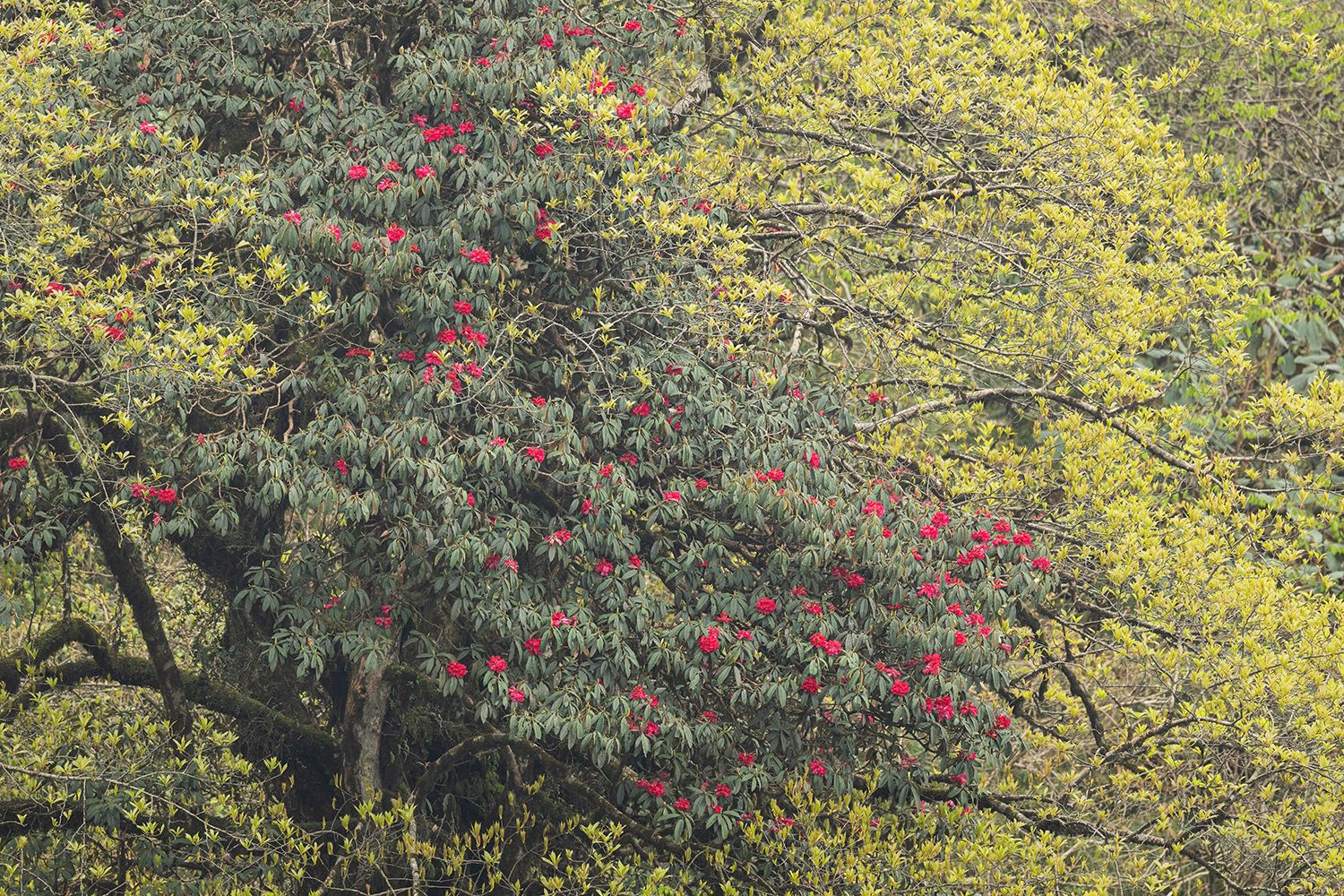
A few minutes into the walk, he suddenly stopped and pointed into the misty forest above us. A few metres away was a vision in red, spotted all over its body and wings, with the dark head barely visible in the fading light. A Satyr Tragopan (Tragopan satyra) stood silently, gazing down upon us. We took turns on the narrow track to get a good look and sneak in a few photographs. A few seconds later, the bird disapparated (to borrow a word from JK Rowling's vocabulary) into its forest.
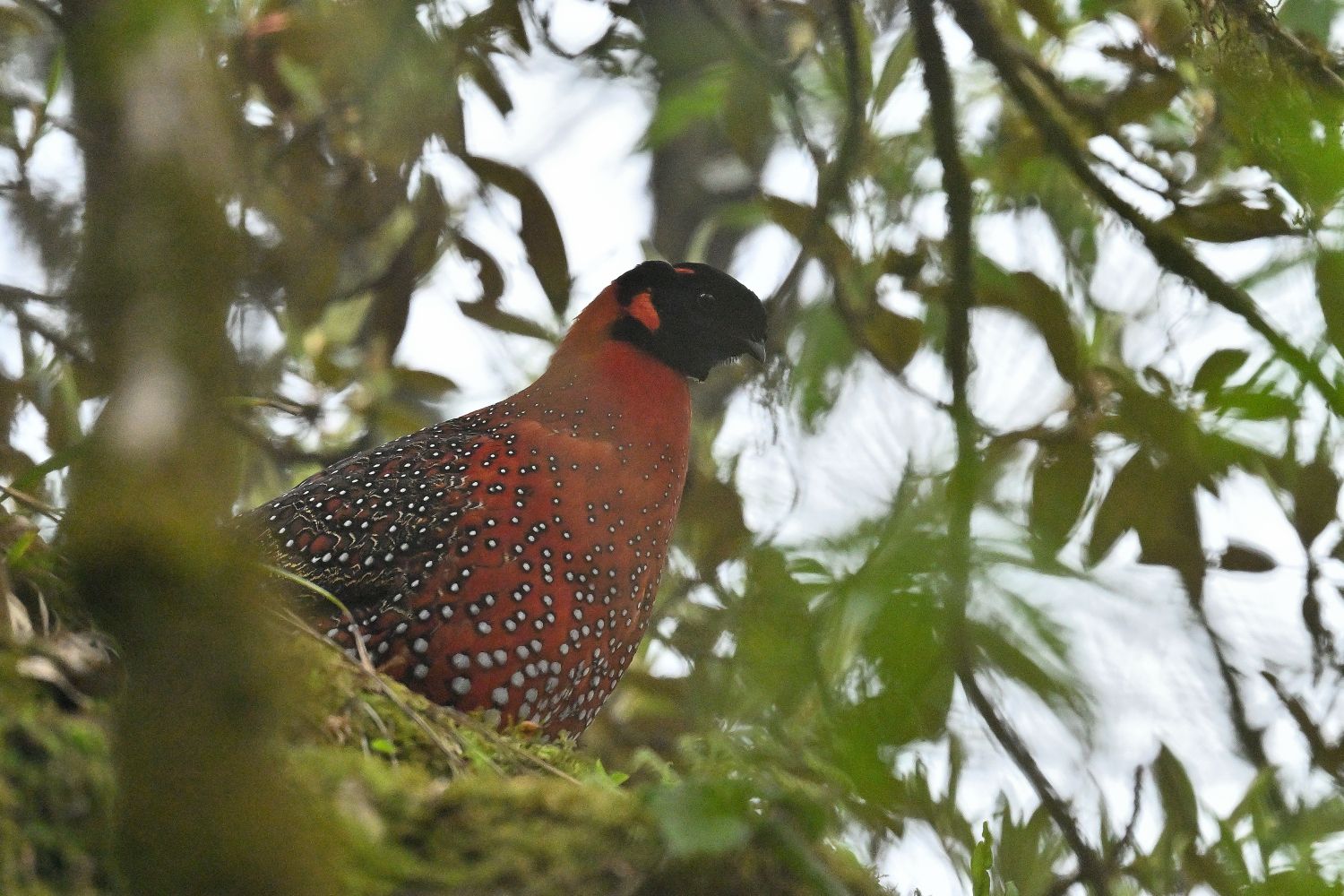
This called for an impromptu celebration. For this was a species that we were really hoping to see on the trip. Pheasants are tough to see everywhere. Tragopans take that to the next level! To see it in the first hour of the trip was so encouraging. It was over the next week that we realised how lucky we had been. Apart from a fleeting glimpse of a bird that took off loudly during one of our walks, we didn't get to see another one of this palette of colours.
The forests that we walked through that evening, and through the rest of the week, seemed straight out of a mystery novel. The mountainsides all around us were draped in lush green, punctuated by tiny settlements and farms. The clouds rose through the forests, helped by the winds to create dynamic and, sometimes, eerie formations. Trees, big and small, were covered with mosses, lichen and epiphytes.
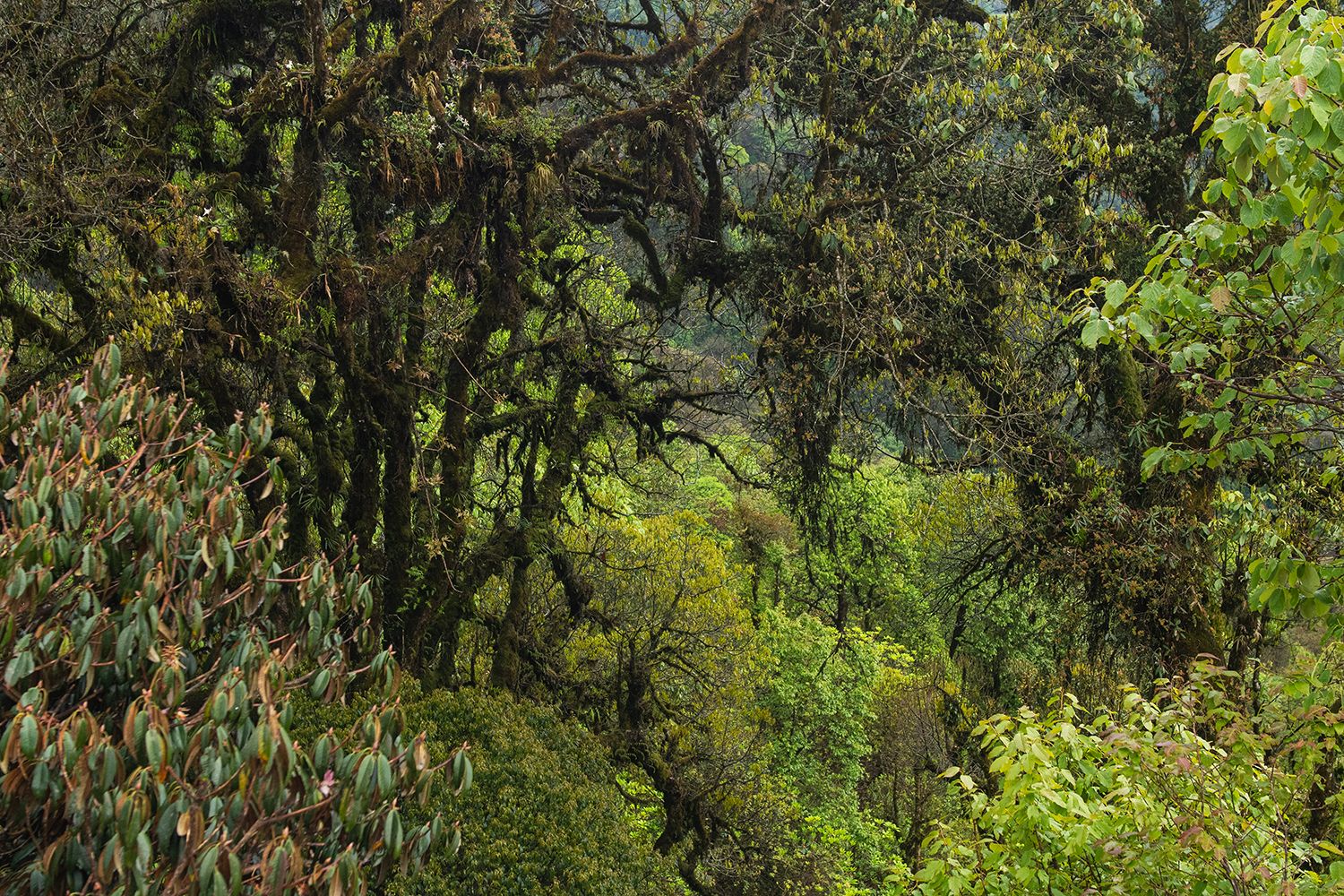
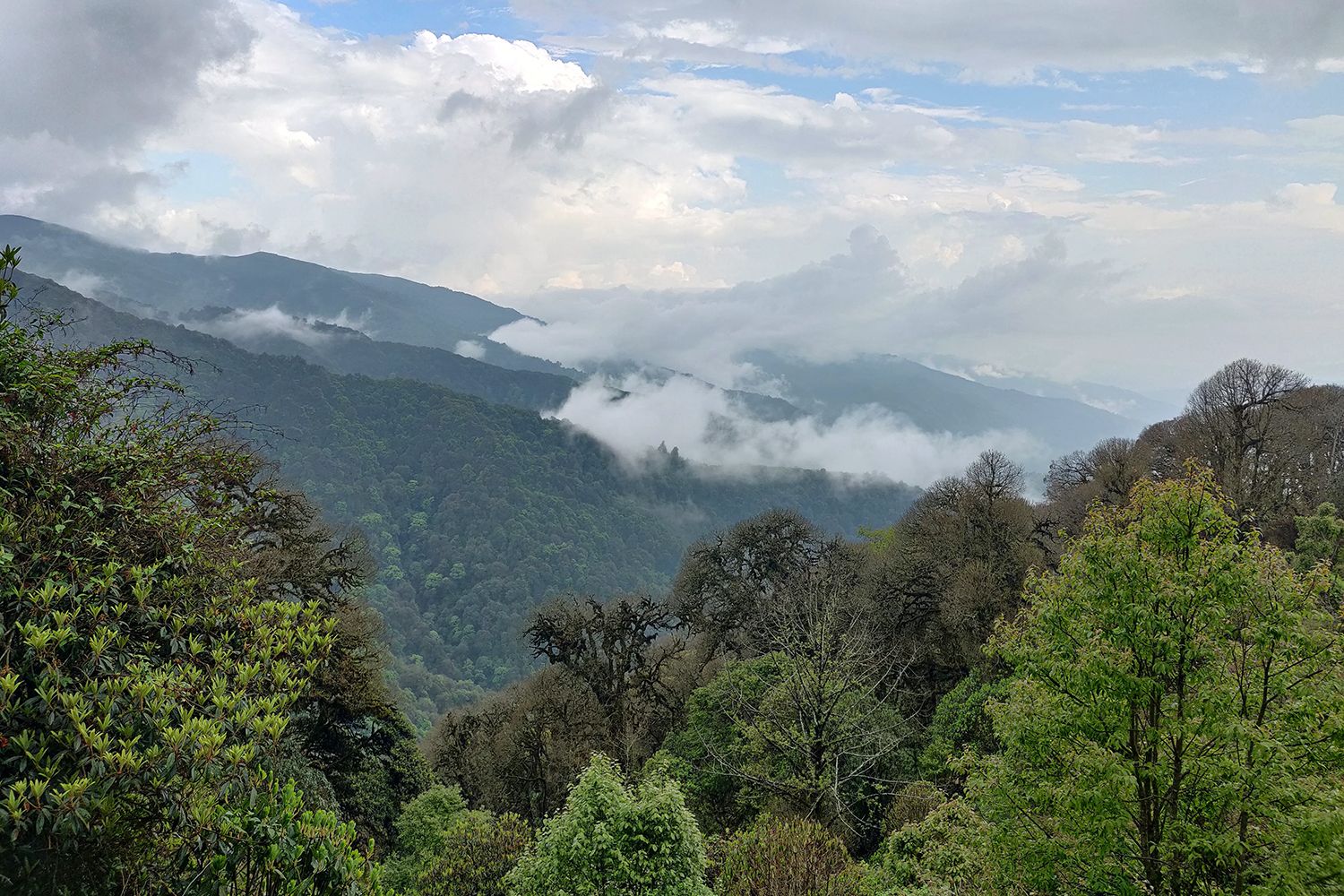

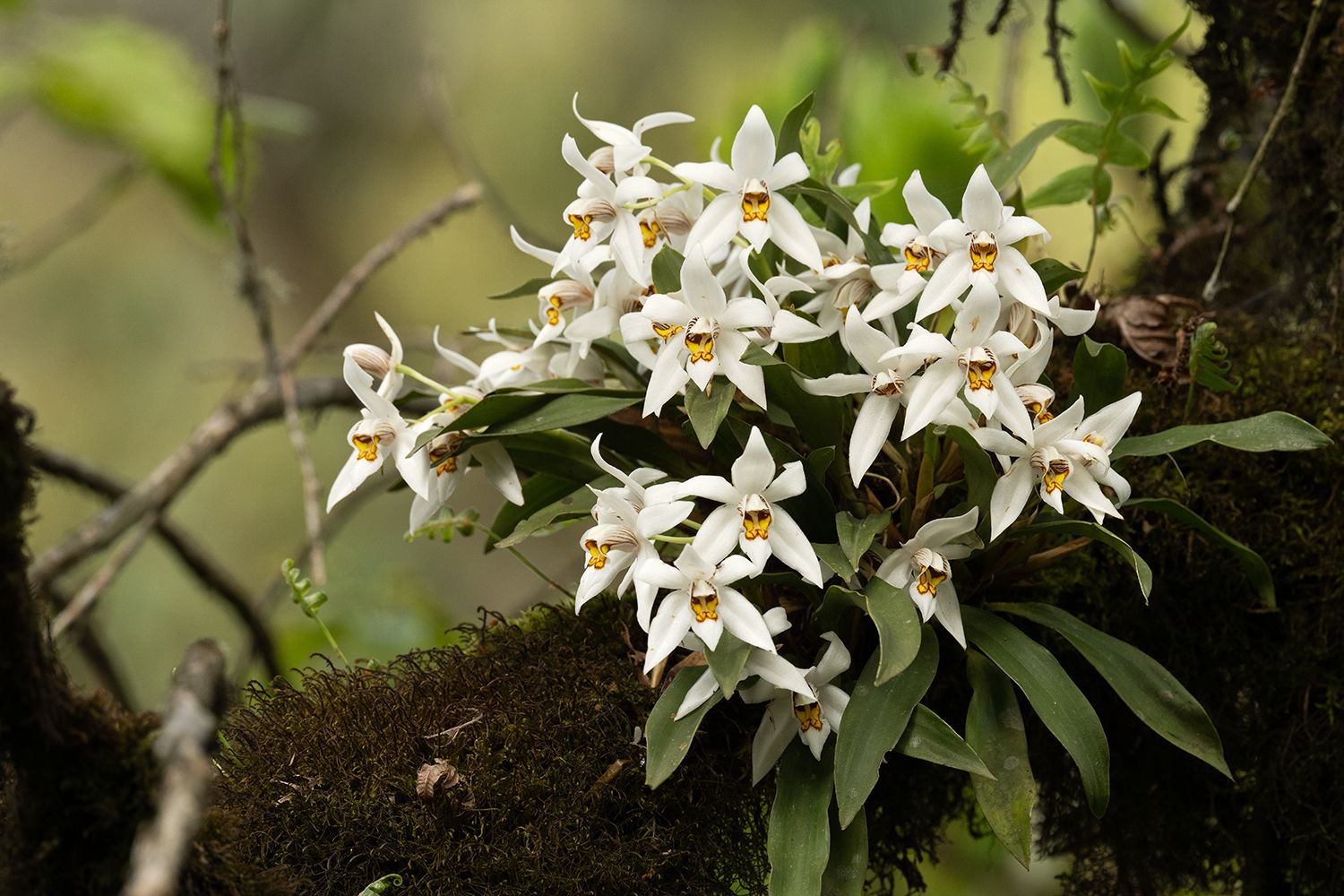
Through the week, we walked on tracks that had been made through the forest to navigate from one village to another. And, for cattle to move to grazing grounds. The rain brought to life myriad streams and tiny waterfalls. It also made the ground slippery in places with no stones or vegetation. This, along with the uneven terrain, meant that we were focused as much on the next step as we were on admiring the forests and looking for signs of animal life.
The mournful whistle of the Hill Partridge (Arborophila torqueola), the two-note call that gives the Cuckoo (Eurasian - Cuculus canorus) its onomatopoeic name, the 4-note call of the Himalayan Cuckoo (Cuculus saturatus) and the "Meh" of the Rufous-vented Yuhina (Yuhina occipitalis) made up the orchestra that gave us constant company in the forests. And, of course, the very different cawing of the Large-billed Crow (Corvus macrorhynchos) from what we are used to back home in peninsular India.
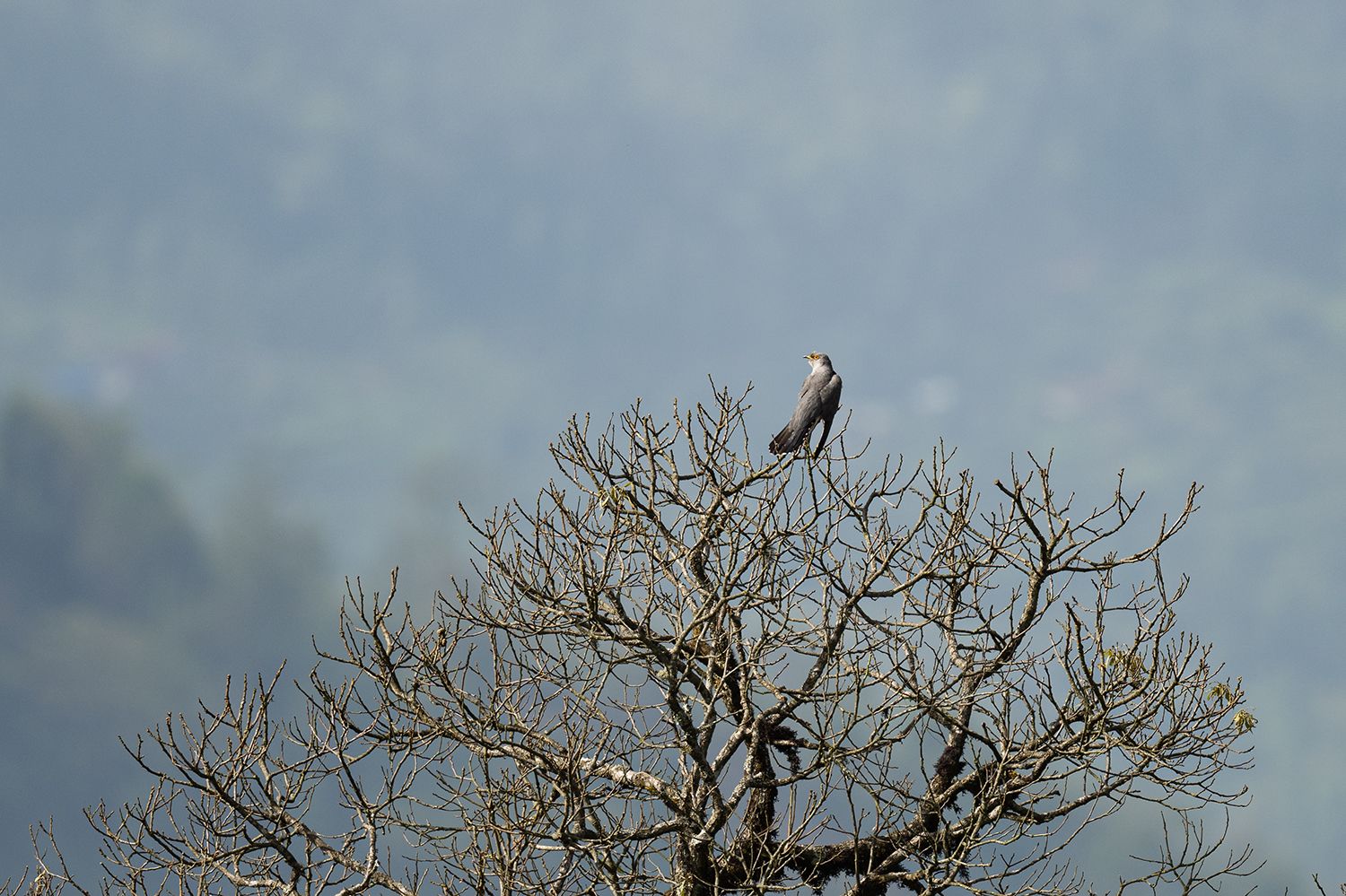
We'd landed up there in a week that was filled with clouds and rain (there was even a hailstorm shortly after we got back from seeing the Tragopan). This made the forest look even more formidable. And mesmerising.
We had a rather fixed schedule everyday. Waking up early to sunny skies brought in fresh optimism about our appointment with Master Shifu. We would see off the group of trackers, who would set out into the forest in different directions. A quick breakfast, typically of fried rice, scrambled eggs and chia, and we would be off into the forest too. Depending on the general area to which the trackers were headed, we would trek for an hour or two to get to a staging point.
The weather would usually change by this time. We would be seeking shelter from the rain or enjoying the near zero visibility that the clouds brought in. Hot chia came out of the thermos, accompanied by raisins, dates and other dry fruits, to keep us energized.
Sometimes the rain stopped and the sun peeked out from amidst the clouds, there would be a sudden burst of bird activity. This was nesting season. While the large mixed hunting flocks of the Himalayas were missing, pairs of birds were actively foraging. Red-tailed Minlas, Green-tailed Sunbirds, Rufous-winged Fulvettas, Bar-throated Sivas, Hoary-throated Barwings, Ashy-throated Warblers and Rufous-gorgeted Flycatchers were commonly seen along the treks, disappearing after a very quick flurry of activity.
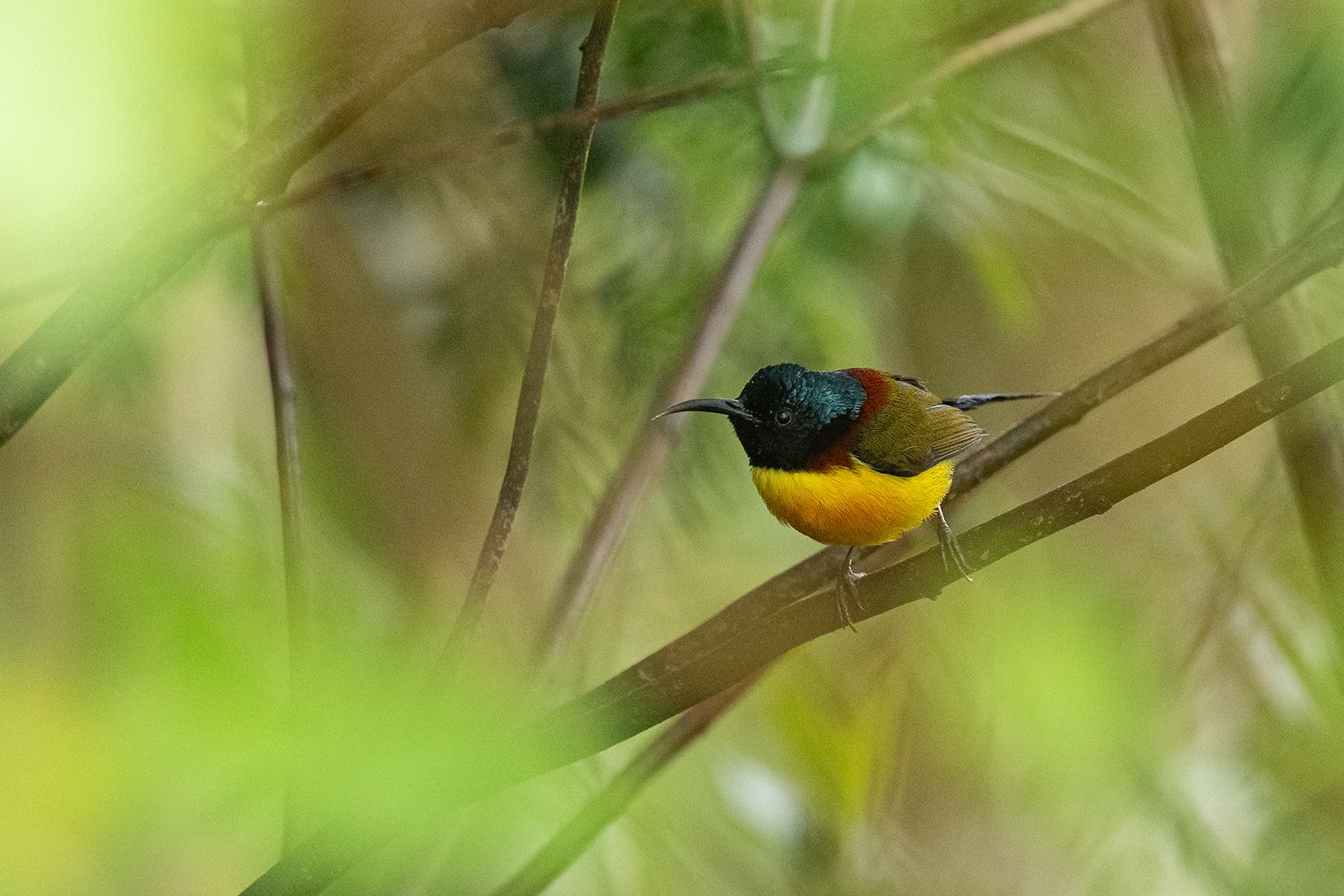
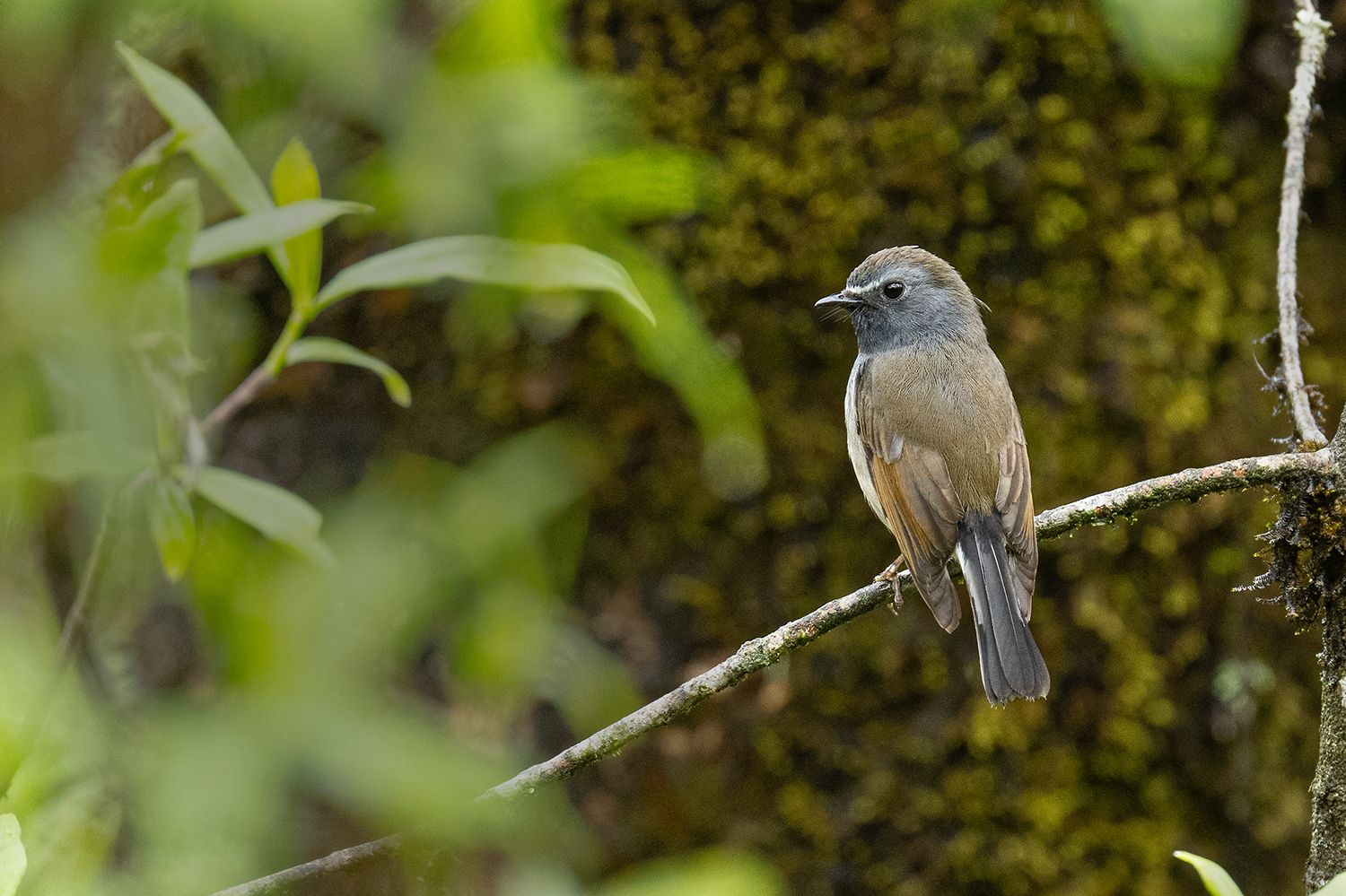



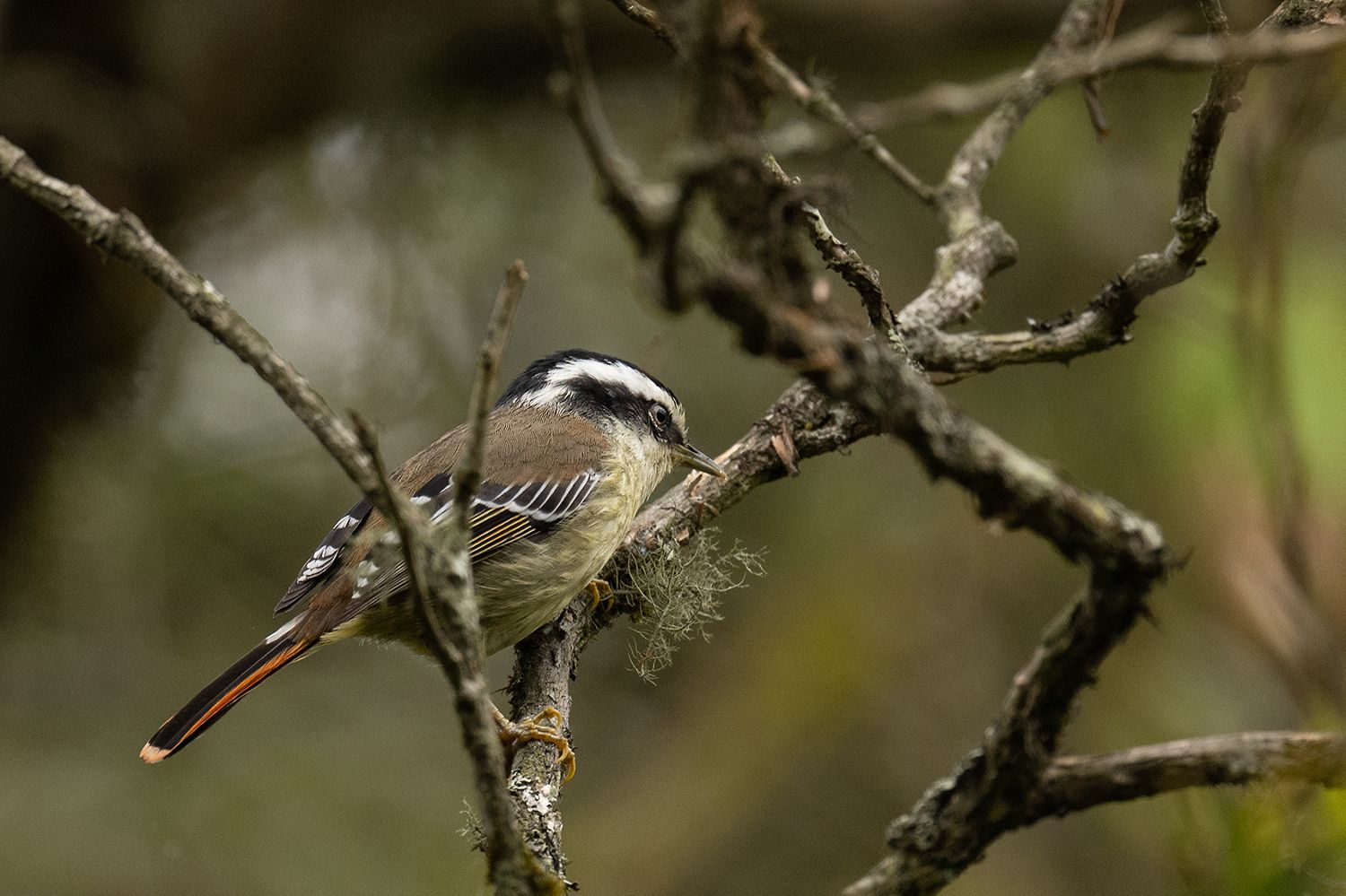
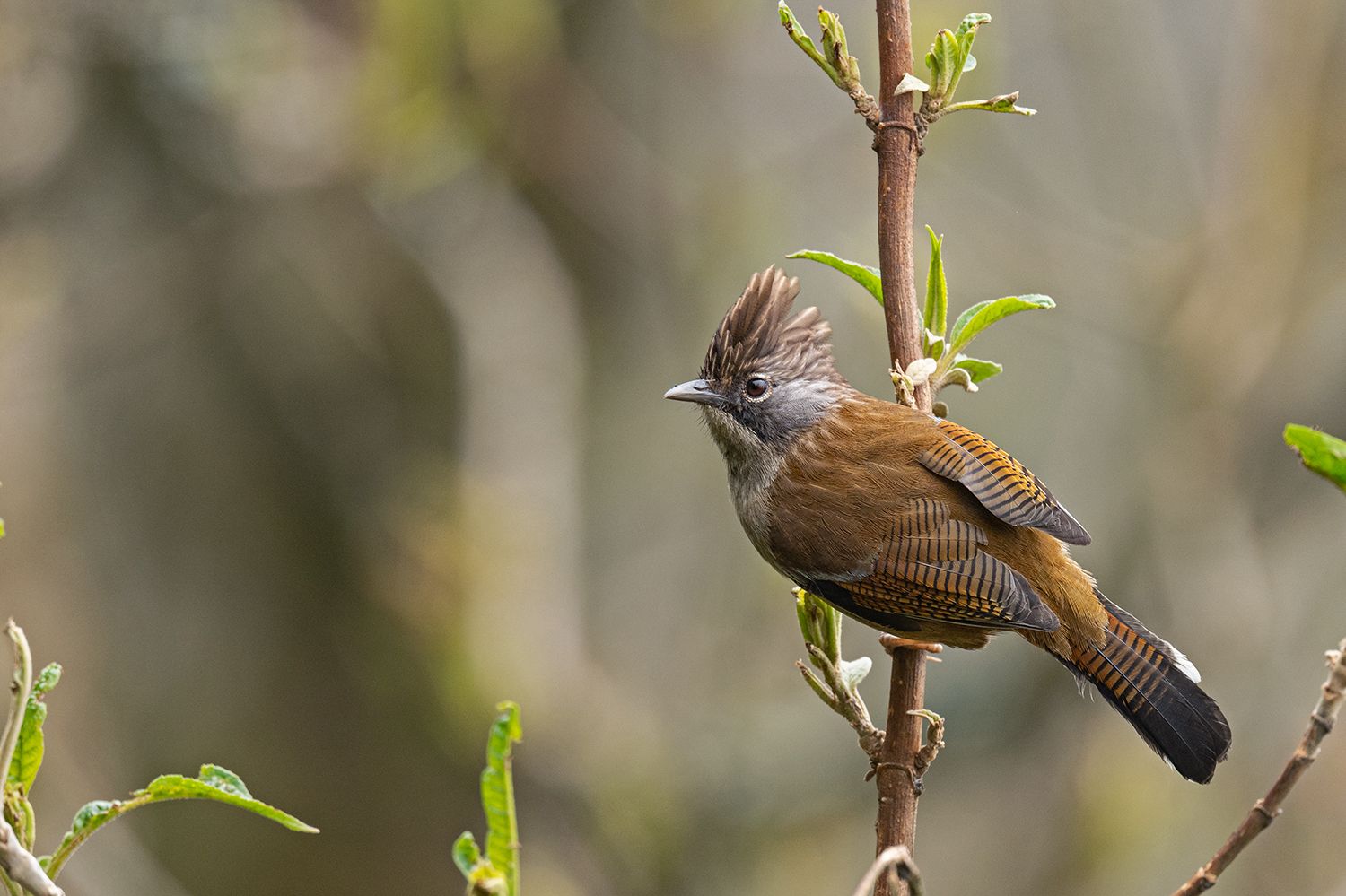
Something struck me as odd. We didn't see any drongos or squirrels. And we didn't hear any cicadas at all. Was it the altitude?
As the clouds continued their dominance over the weather, the Red Panda became even more elusive. How does one find an animal that's about the size of a domestic cat in a vast montane forest when visibility is just a few metres? These animals are usually on trees, but also use the ground often to navigate to food, rest and safety. The mist made everything rather monochrome, making it possible only for the keenest and most experienced eyes to differentiate between a mossy branch and a furry mammal. By mid-day, the trackers returning home signalled that our slim chance of a sighting had almost vanished. We would slowly walk back to basecamp.
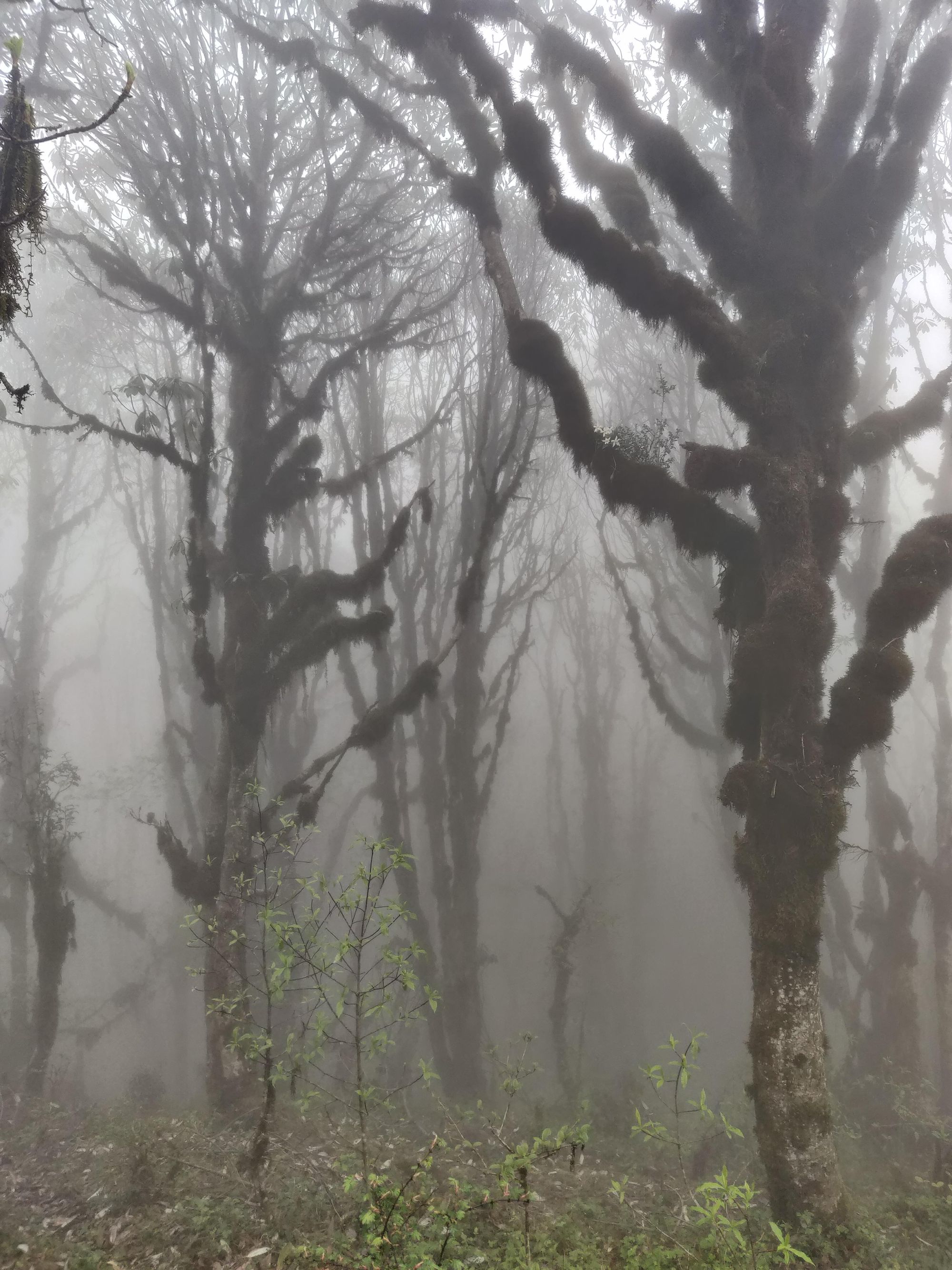
Back at the homestay, Verditer Flycatchers, Yellow-billed Blue Magpies and Green-backed Tits would frequent the trees and the garden around the house. Eurasian Hobbies and Himalayan Vultures were often seen in the mornings.
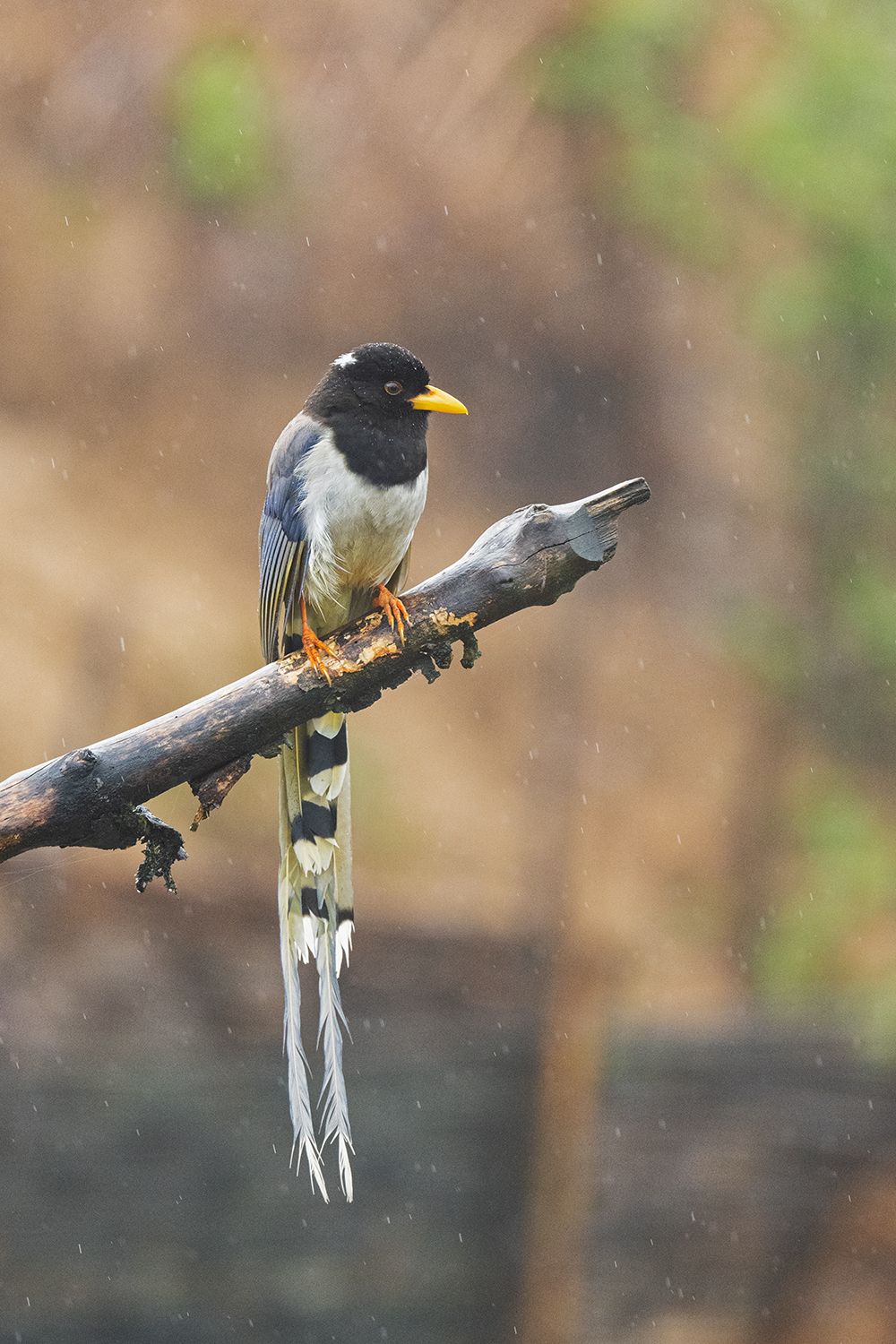
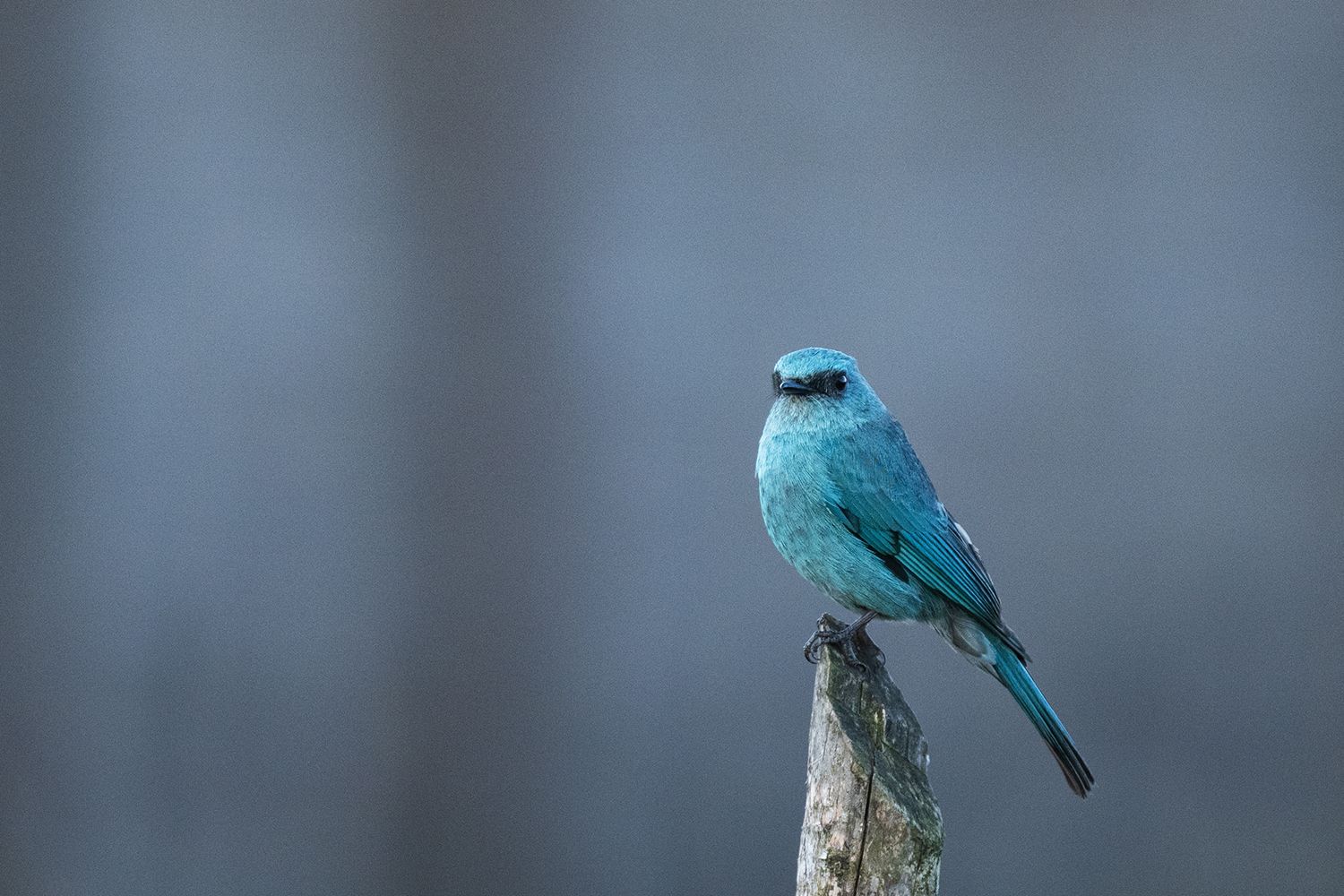
As the sun set, it would be time for dinner. An early dinner meant an early bedtime, giving us enough time to rest before we set off into the mountains again in the morning.
Every day began merging into the next, without as much as a glimpse of the Firefox. SS remained stoic about it, without any false promises of hope. "We couldn't find it today too. Let's see tomorrow." Not that it bothered us much. We were already high on nature's bounty around us. The mysterious cloud forests had us in their sway. Yes, seeing a Red Panda would be the cherry on the proverbial cake. But we were already stuffing ourselves with the cake! Every morning, the trek into the forests was the one thing we looked forward to.
On the seventh (and the last) day of our expedition, the winds of change (sorry for the cliche; couldn't resist) seemed to be blowing. The weather suddenly cleared up that morning, without as much of a hint of a cloud in the saturated blue sky. The valleys were clear and optimism bubbled through. Could today be the day?
We set off on our walk after breakfast. A glimpse of a Barred Cuckoo-Dove (Macropygia unchall) through the foliage felt like a lucky charm. A few months ago, we'd started the day with a Barred Cuckoo Dove and ended it with sighting Golden Langurs in Manas. Would the charm work today?
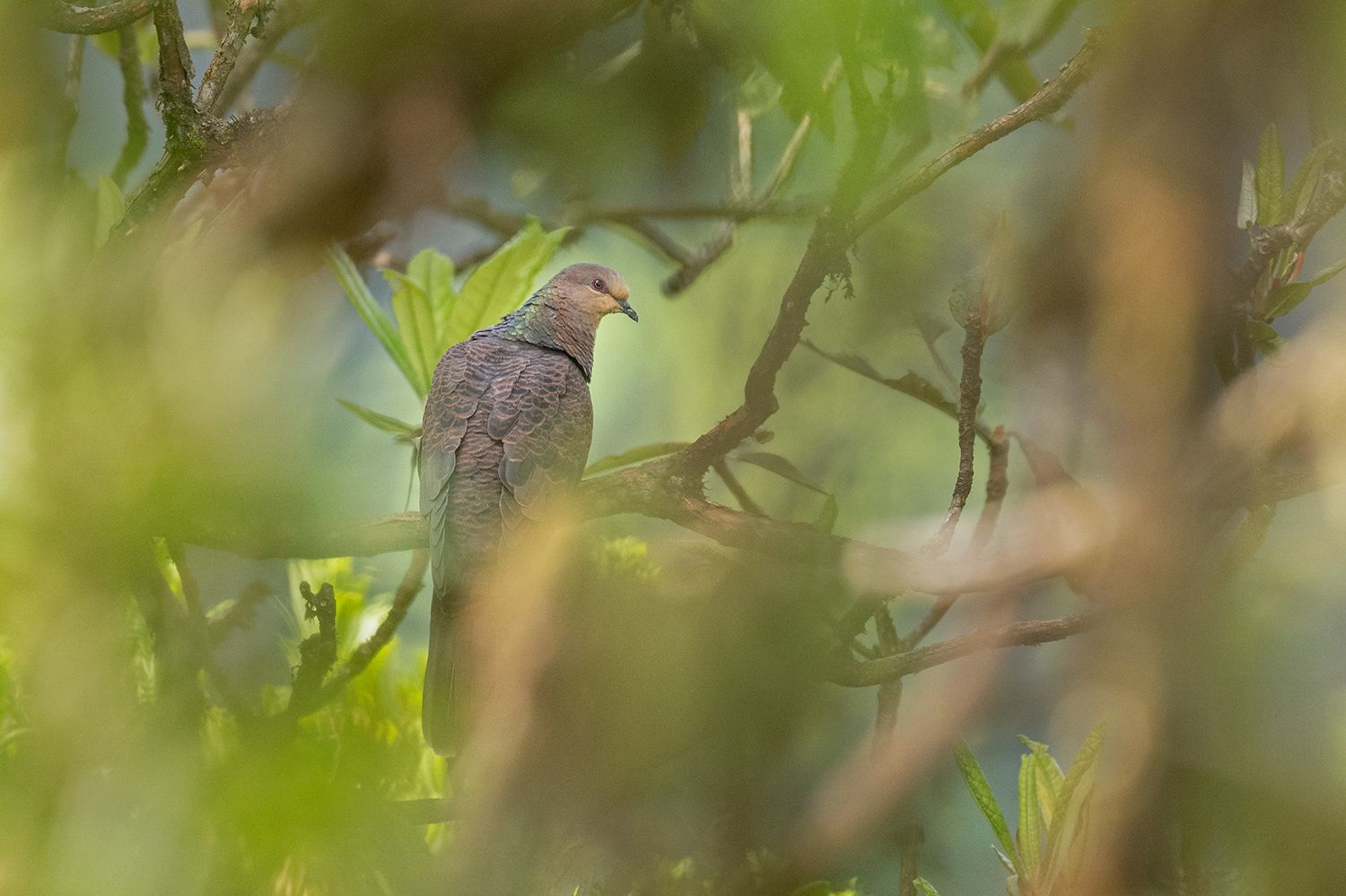
My friend Manish Lakhani often says, "2 things can never be guaranteed. The fashion in Mumbai. And the weather in the mountains." A couple of hours into the walk, we were hurrying for cover from the sudden torrential rain. A large tree gave us some shelter. If you are a cricket aficionado, you'll remember this board from the semi-finals of the 1992 World Cup. Needless to say, that's how we felt our hopes disappearing with the rainfall.

It was almost mid-day by the time the rain eased. We settled down with our chia, biscuits and dry fruits to take in the cloud forest for one last time. Our guide was hurrying down the path towards us, with a smile on his face. "Panda mil gaya" (they found a Panda).
A week of practice in walking on the mountain trail paid off. The Panda was a couple of mountains away and we had to rush there. 45 minutes of sprint-stop for breath-sprint later, we saw a tracker waiting for us. And then we followed him for another 10 minutes (that seemed never-ending) to reach another tracker. He was pointing towards the forest by the track - a maze of bamboos on a steep upward slope that was slushy and, judging by the boot marks of the trackers, slippery. The hesitation in my mind was drowned out in a fraction of a second and I rushed into the bamboo.

Slipping and falling, holding onto the bamboos for support (hoping, for a change, that there were no Pit Vipers around), I reached the place where SS was waiting. He said that the Red Panda was right above me. It took me a few minutes to realize that it was just a few feet away, only a part of its face visible. It was investigating me with its beady eyes.
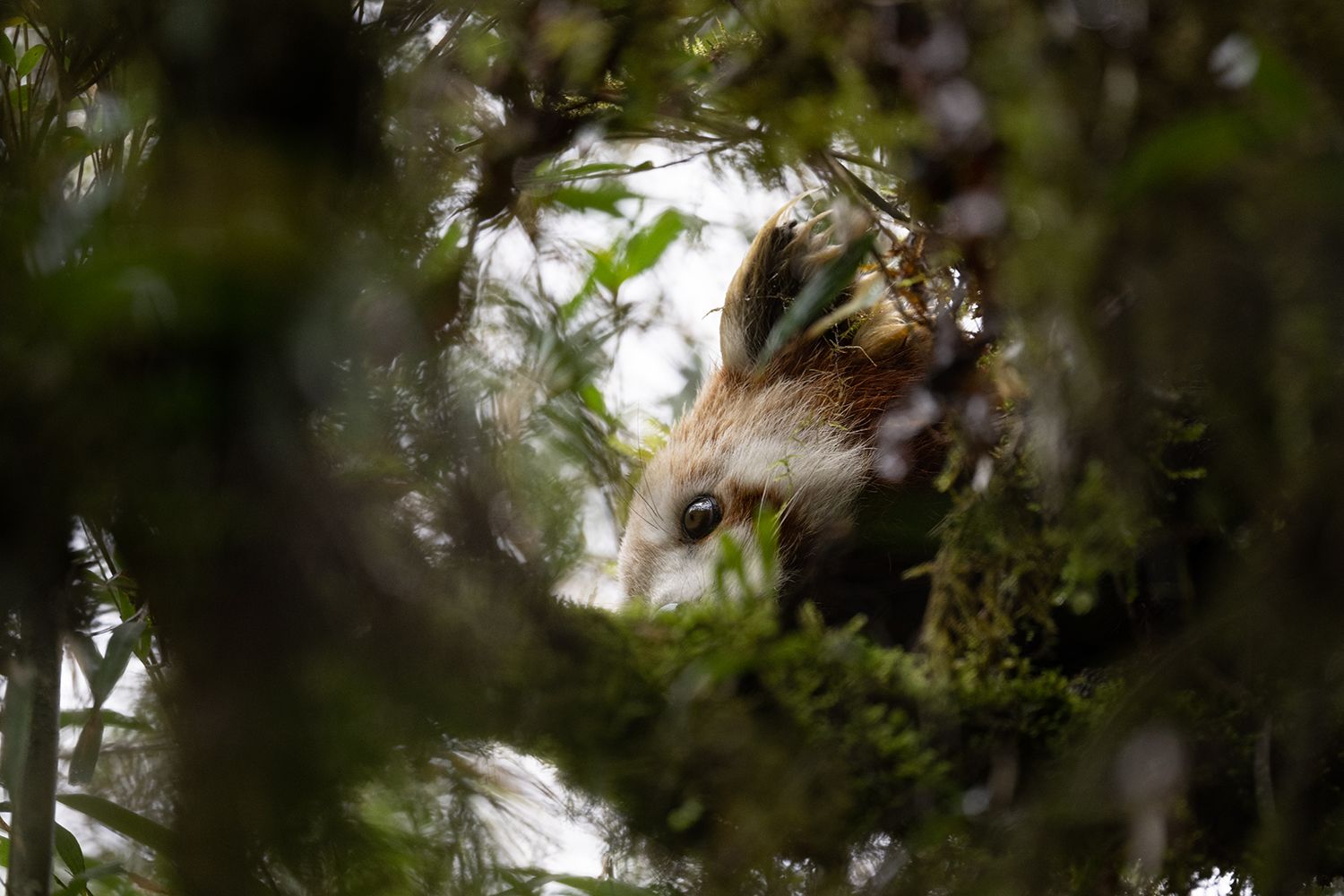
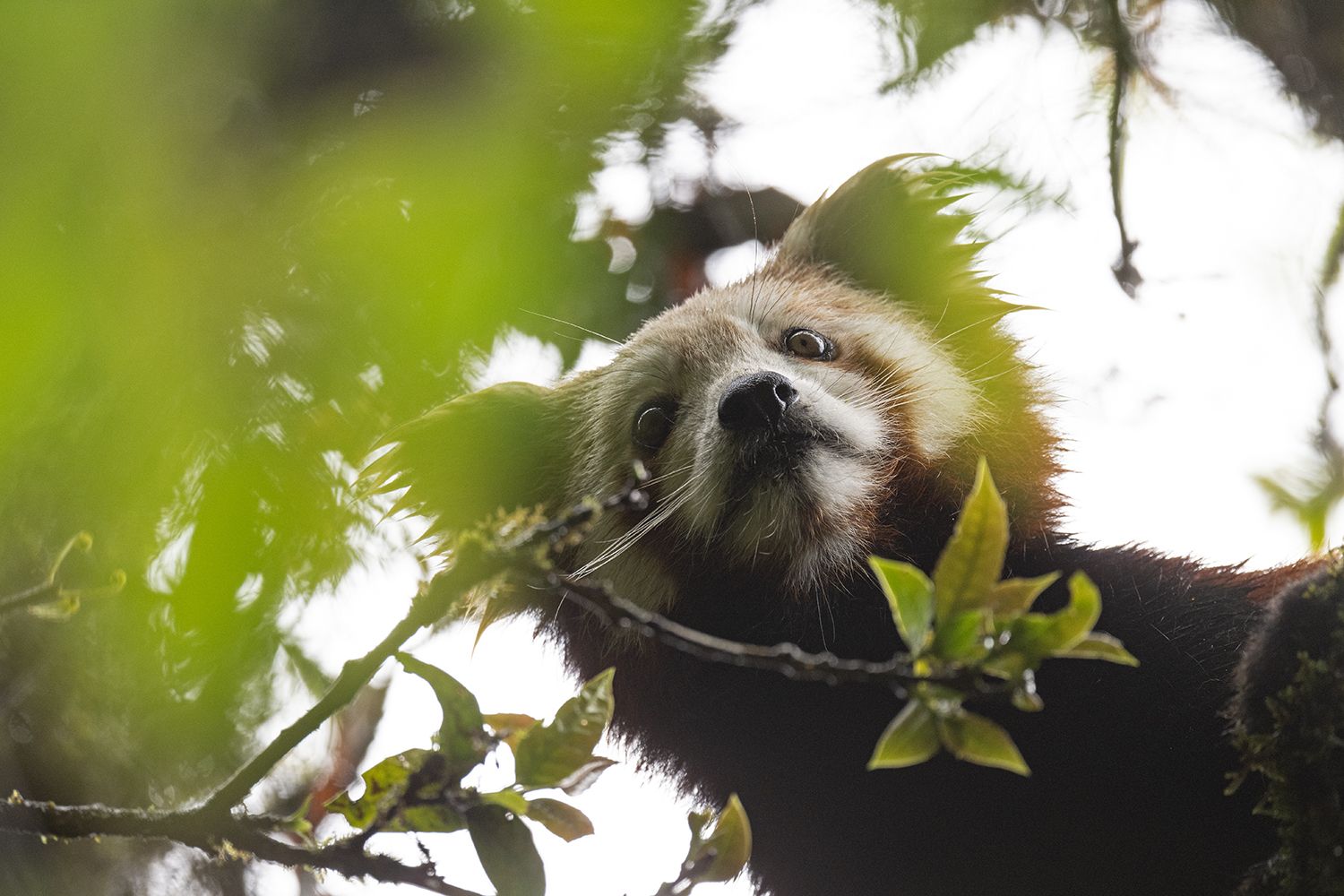
I was coaxed to climb up a bit more to get a better look at the Panda. A few minutes more of climbing, slipping and falling later, I got onto a narrow ledge where the Red Panda was right in front of me. I wanted to say "Master!", and do the Kung-fu Panda salute. My reluctance to slip and fall from my precarious perch kept me from resorting to said antics.
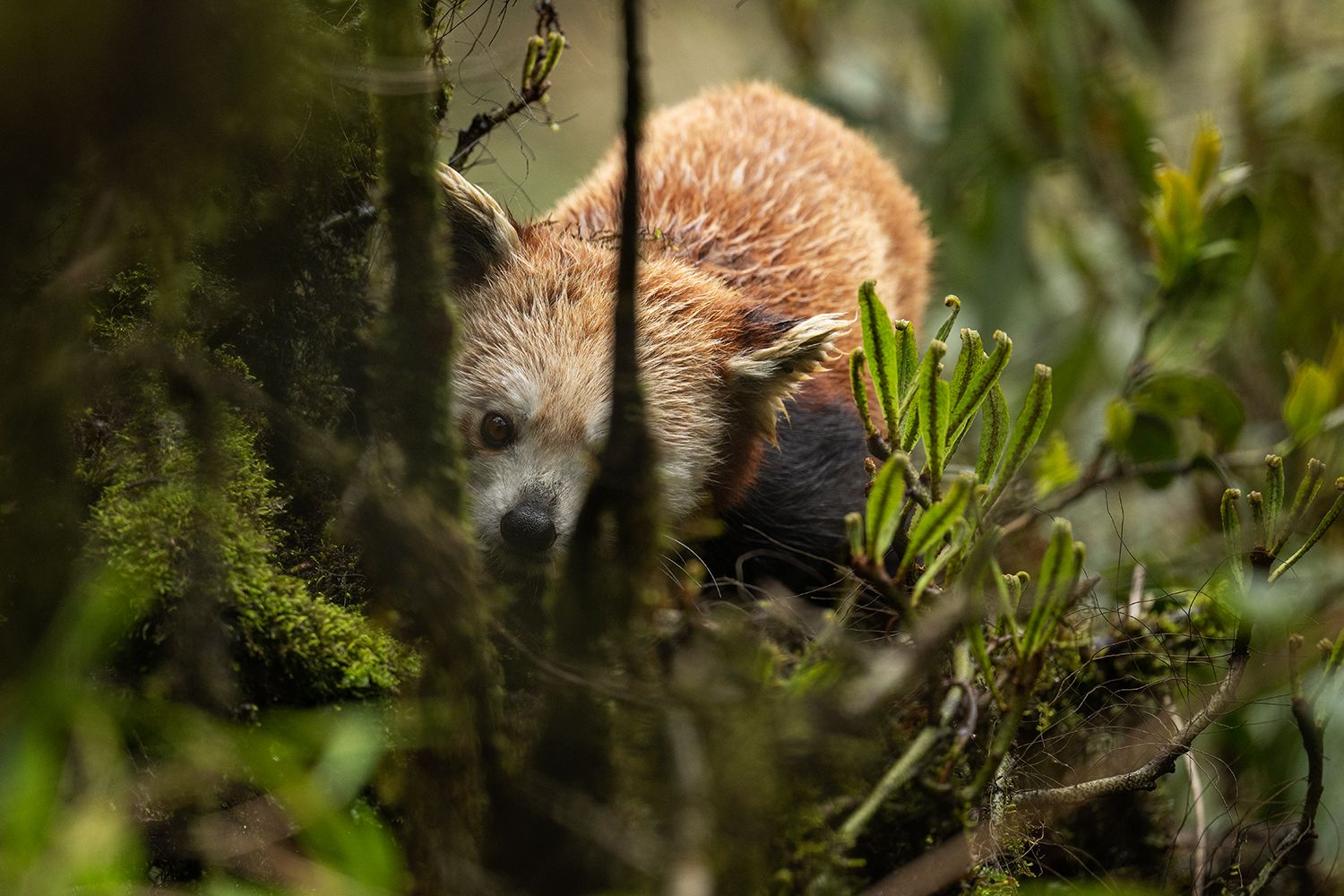
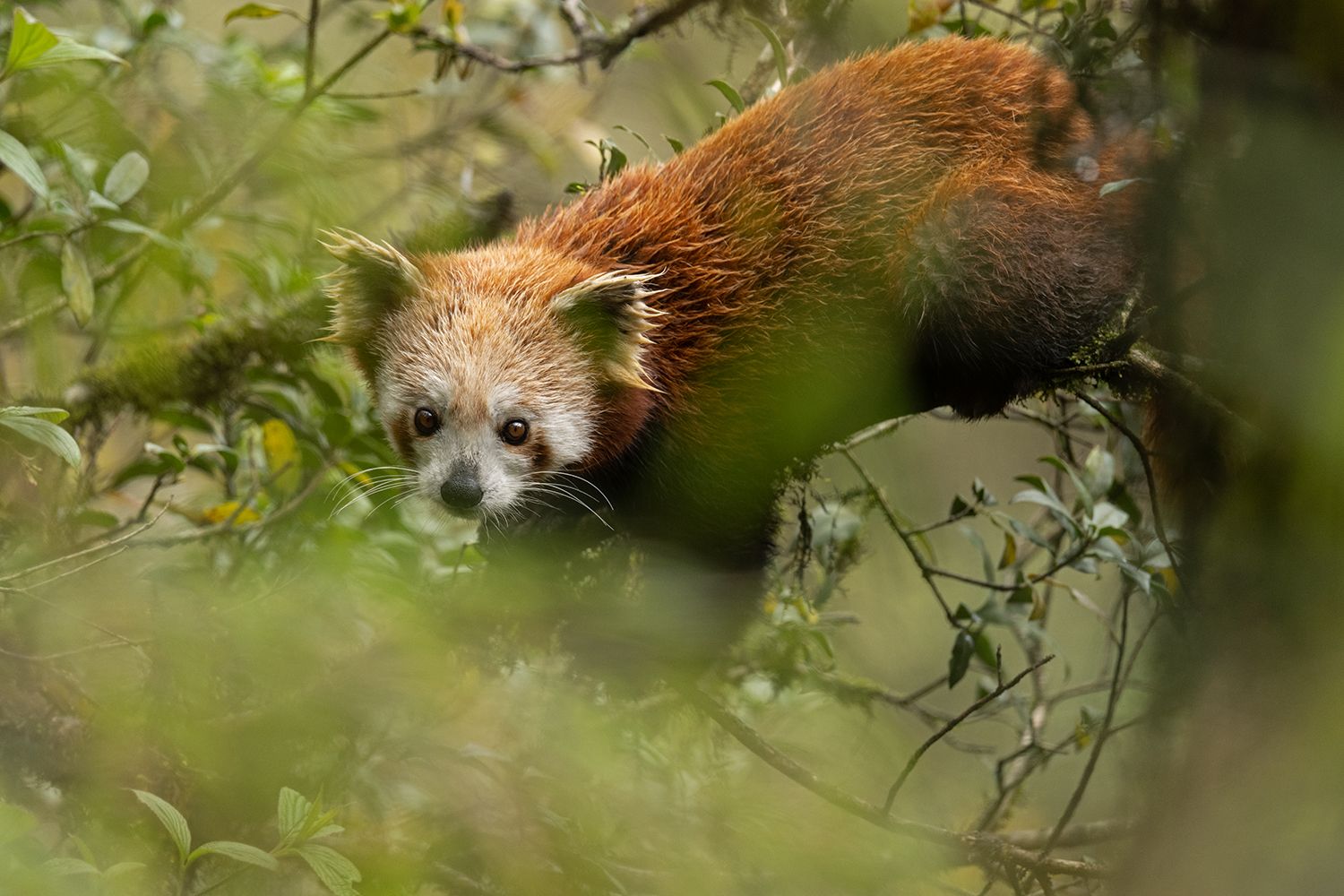
Each moment up there seemed so precious. I would pick up my camera once in a while to take a few photographs (at 20fps, a few photographs means a LOT of them!) "Wrong choice of lens", I told myself. I was stuck with a 500mm prime lens in which I couldn't photograph the entire animal. I couldn't move backwards as I would lose a clear line of sight. "Are you stupid? There's a Red Panda right there and you're bothered about your camera. Savour these moments", argued the more logical part of my brain.
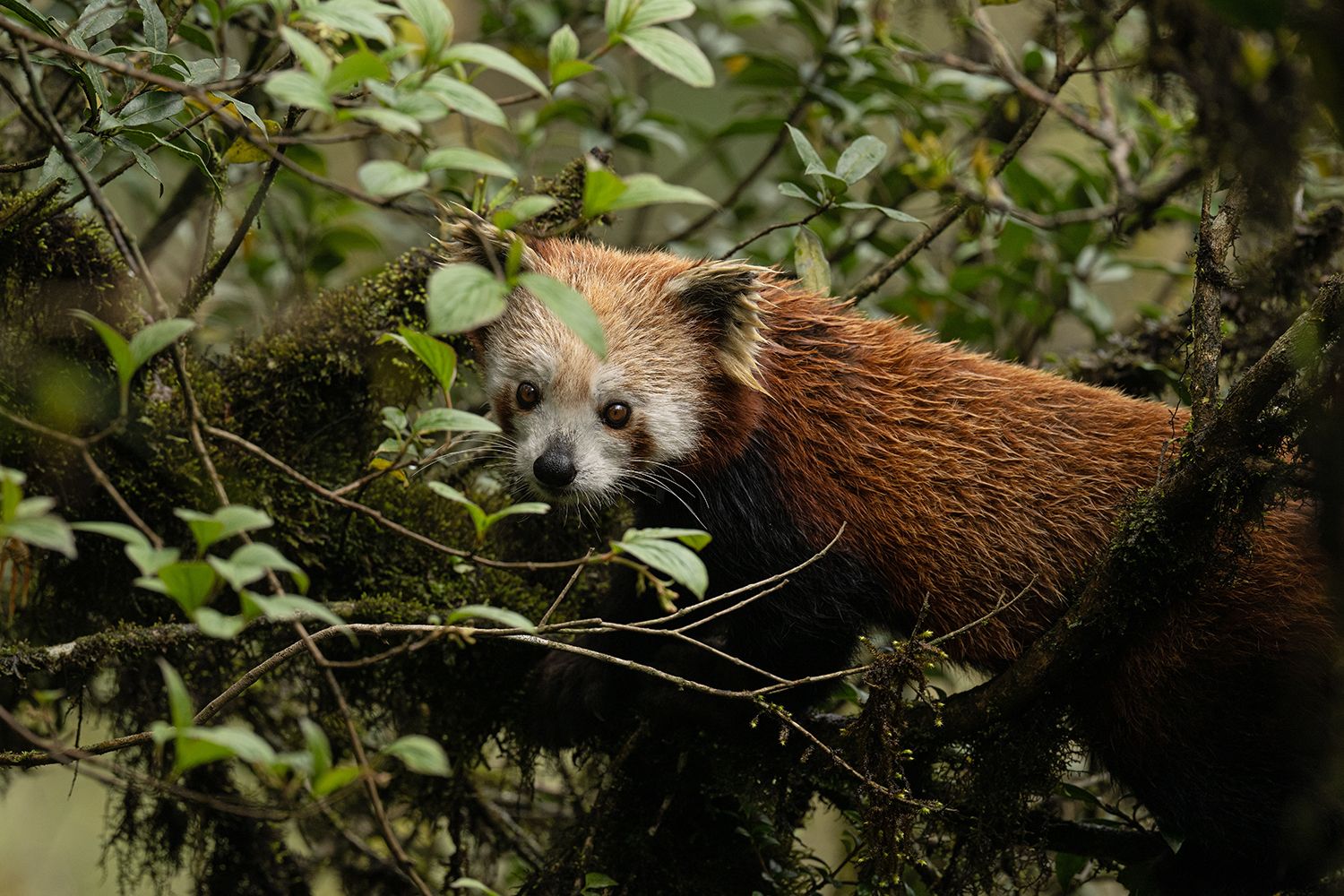
It seemed forever before the Red Panda decided to move on. A feeling of peace swept over me. And then the realisation, "How am I going to get back to the road from here?" Easy! I just sat down and slid all the way to the track, making sure to avoid the bamboos.
The Red Panda (Ailurus fulgens) is an endangered mammal that is found from Nepal, through parts of north-eastern India, Bhutan, southern Tibet and Myanmar, till China's Sichuan and Yunnan provinces. It is placed in its own family - Ailuridae - as it is not closely related to any other animal. Not even the Giant Panda (the protagonist of Kung-fu Panda, which actually happens to be a bear), though both animals have a common diet of bamboo and have elongated wrist bones (or false thumbs) for grasping bamboo.
Two subspecies are recognised, and we saw the nominate fulgens subspecies (also known as Himalayan Red Panda) in Nepal. They feed primarily on bamboo leaves, with fruits, flowers, birds, eggs and small mammals also forming part of their diet.
The Red Panda is threatened by destruction and fragmentation of its habitat. Bamboo habitats are disappearing due to multiple reasons, including increasing human settlements, deforestation and trampling of bamboo habitats by domestic cattle. Illegal poaching and feral dogs add to the Panda's problems. The Red Panda Network estimates that there are fewer than 2500 Red Pandas remaining in the wild, with numbers dropping as much as 50% in the last 20 years!
Back at the homestay, it was party-time. The trackers had been invited to a feast of chicken. "This was a last-ball sixer!", one tracker said. "A goal in overtime", insisted another. Sports metaphors were the flavour of the day.
The night sky was celebrating too, with a full display of stars and not a cloud to be seen anywhere.
As we drove down the next morning, on our way back to India, the roads under construction promised that the next drive up would be smoother for our backs. But, what do these roads mean for the Red Panda? Can the fragile ecosystem handle more people and more traffic rushing through?
Note: I've withheld the exact location and names of our hosts and guides upon request. If you know about this place, please refrain from mentioning it in the comments. Thanks!
